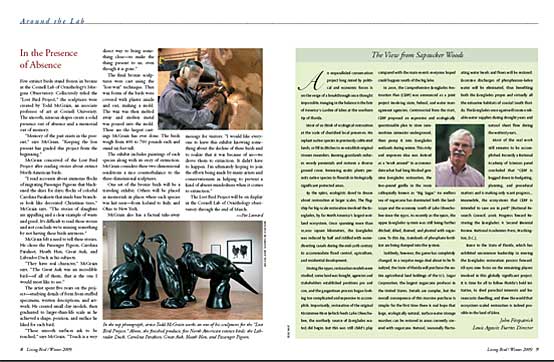View From Sapsucker Woods: Can We Restore the Everglades?
By John Fitzpatrick January 15, 2009

An unparalleled conservation project long mired by political and economic forces is on the verge of a breakthrough once thought impossible. Hanging in the balance is the fate of America’s Garden of Eden at the southern tip of Florida.
Most of us think of ecological restoration at the scale of cherished local preserves. We replant native species in previously cultivated lands, or fill in ditches to re-establish original stream meanders. Burning grasslands reduces woody perennials and restores a diverse ground cover. Removing exotic plants permits native species to flourish in biologically significant protected areas.
By the 1980s, ecologists dared to dream about restoration at larger scales. The flagship for big-scale restoration involved the Everglades, by far North America’s largest wetland ecosystem. Once spanning more than 10,000 square kilometers, the Everglades was reduced by half and riddled with waterdiverting canals during the mid-20th century to accommodate flood control, agriculture, and residential development.
During the 1990s, restoration models were studied, some land was bought, agencies and stakeholders established positions pro and con, and the gargantuan process began looking too complicated and expensive to accomplish. Importantly, restoration of the original Kissimmee River (which feeds Lake Okeechobee, the northerly source of Everglades water) did begin. But this was still child’s play compared with the main events everyone hoped could happen south of the big lake.
In 2000, the Comprehensive Everglades Restoration Plan (CERP) was announced as a joint project involving state, federal, and water management agencies. Controversial from the start, CERP proposed an expensive and ecologically questionable plan to store summertime rainwater underground, then pump it into Everglades wetlands during winter. This risky and unproven idea was derived as a “work around” to accommodate what had long blocked genuine Everglades restoration, the 800-pound gorilla in the room colloquially known as “Big Sugar.” An endless sea of sugarcane has dominated both the landscape and the economy south of Lake Okeechobee since the 1930s. As recently as the 1960s, the upper Everglades system was still being further ditched, diked, drained, and planted with sugarcane. To this day, trainloads of phosphate fertilizer are being dumped into the system.
Suddenly, however, the game has completely changed. In a surprise mega-deal about to be finalized, the State of Florida will purchase the entire agricultural land holdings of the U.S. Sugar Corporation, the largest sugarcane producer in the United States. Details are complex, but the overall consequence of this massive purchase is simple: for the first time there is real hope that large, ecologically natural, surface water storage marshes can be restored in areas currently covered with sugarcane. Natural, seasonally fluctuating water levels and flows will be restored. Excessive discharges of phosphorous-laden water will be eliminated, thus benefiting both the Everglades proper and virtually all the estuarine habitats of coastal South Florida. The Everglades once again will receive reliable water supplies during drought years and natural sheet flow during the wettest years.
Most of the real work still remains to be accomplished. Recently a National Academy of Sciences panel concluded that “CERP is bogged down in budgeting, planning, and procedural matters and is making only scant progress… Meanwhile, the ecosystems that CERP is intended to save are in peril” (National Research Council. 2008. Progress Toward Restoring the Everglades: A Second Biennial Review. National Academies Press, Washington, D.C.).
Bravo to the State of Florida, which has exhibited uncommon leadership in moving the Everglades restoration process forward. All eyes now focus on the remaining players involved in this globally significant project. It is time for all to follow Florida’s bold initiative, to shed parochial interests and bureaucratic dawdling, and show the world that ecosystem-scaled restoration is indeed possible in the land of Eden.


All About Birds is a free resource
Available for everyone,
funded by donors like you





